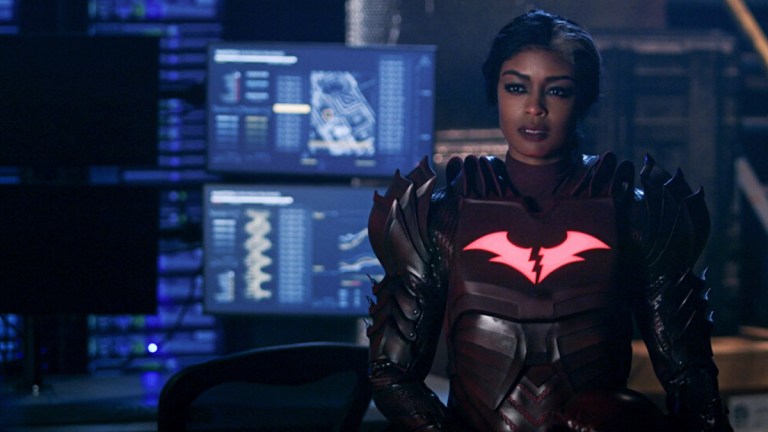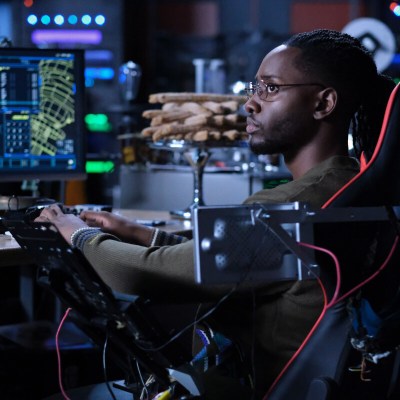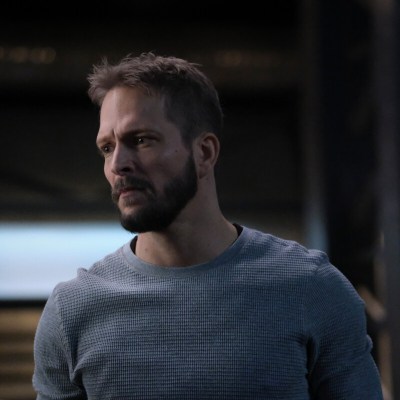The Flash: Mask of the Red Death Brings Closure to Batwoman
Exclusive: Batwoman star Javicia Leslie talks playing The Flash's Red Death and saying a proper goodbye to Ryan Wilder.

This Flash article contains spoilers.
The Flash Season 9 Episode 5
As the final season of The Flash barrels toward its endgame, the stakes keep getting higher. “The Mask of the Red Death, Pt. 2” not only sees Barry and Team Flash finally bring the villainous Red Death to justice, but also reveals Iris is pregnant, sees Chester and Allegra finally admit that they’re crazy about one another, and features Khione displaying some sort of strange new healing abilities that save a badly injured Mark Blaine. While these are all the sort of big narrative events that the show normally saves for a season finale, it’s the surprise return of Batwoman heroine Ryan Wilder that likely packs the biggest emotional punch.
With much of The CW Arrowverse wrapping up alongside The Flash’s final season, the fact that the show is managing to include characters from across this superhero universe is incredibly satisfying. Particularly since Batwoman didn’t really get the opportunity to go out on its own terms (plus, there’s no timeline in which a Batwoman versus Red Death fight isn’t incredibly cool to watch).
“We got the chance to give Ryan and Batwoman an appropriate goodbye,” Javicia Leslie, who plays both Red Death and Batwoman’s Ryan Wilder over the course of this arc, tells Den of Geek. “Because when we ended [the show], we didn’t know we weren’t coming back. We kind of left it on a cliffhanger, so Eric coming up with this idea—it opened the door to really being able to do that. And not just say goodbye, but to play a character like Red Death at the same time? It was so much fun. And I think we did it in a really epic way. We really did it in a creative way. I’m so appreciative of that.”
Leslie’s performance as the deranged Red Death—a version of Ryan from an alternate timeline—has been wildly entertaining to watch, a satisfying mix of cunning and crazy (with a dollop of otherworldly advanced technology on top) that makes her unlike any villain that Team Flash has faced before. And, yet, if you squint, it’s not that difficult to see how she’s not really that different from the Ryan Wilder we know, who also wants to fight crime in a city in desperate need of justice.
“You have to have fearlessness when you play villains,” Leslie says. “You have to, because if you think about all your greatest villains, and especially those in [Batman’s world], they all believe that they are justice. It’s very few of them that are killing just to kill. Most are doing it based on what they believe in, and there’s no difference with Red Death because she believes what she’s doing is right.”
Leslie describes Red Death’s “obsessive” idea of justice as “unhinged,” because it tends to skew a lot closer to exacting vengeance or doling out punishment than it does actually helping those that need it.
“The problem, which is what makes her different from good Ryan or Batwoman, is that while Red Death will do anything for the justice that she wants, and if you pay close attention, it’s actually more of a power trip,” she says. “Because true justice maybe means you won’t be the winner in the end. And [Red Death] wants to be in control over everything, so it ultimately stops being about justice and starts being about power. Batwoman obviously wants justice, but she has rules—I think as a hero you have to create rules. You have to create a sense of morality you will follow no matter what. And that’s what Batwoman has that Red Death does not have.”
The Flash’s take on Red Death is, of course, quite different from the DC Comics version of the character, given that showrunner Eric Wallace says he was essentially forbidden from using Bruce or Thomas Wayne and therefore ”couldn’t really dip into the Dark Nights: Metal storyline.” But, according to Leslie, the opportunity to build her own take on the character was freeing.
“I haven’t really done my full research, but I don’t [think] Red Death has ever been brought to live action before,” she says. “So we didn’t really have anything to go off of but our own creativity. It made it fun, and it let us make it our own.”
And despite the fact that Red Death gets to utter multiple famous Batman lines, including “I am vengeance” and “let’s get nuts,” the actress didn’t try to incorporate any elements of previous Dark Knights into her performance.
“I tried my hardest not to look at them as iconic lines and just do [the scenes] organically based off of what was going on in the moment before those lines were said,” she explains. “I didn’t go back and rewatch other people saying them because those [characters’] circumstances were different than mine. I worried more about being in the moment and responding to the circumstances in front of me. I didn’t want to do what had already been done.”
Because for Leslie, while there are some similarities between these alternate versions of Ryan Wilder, what ultimately sets the two apart, in the end, is the choices they make.
“Bad Ryan was adopted, good Ryan was adopted. Bad Ryan had a best friend named Iris, good Ryan has a friend named Iris. And bad Ryan wants people to be protected against evil and so does good Ryan, so they both have that in common,” she says. “But I think it’s what happens when things don’t go their way, that they react differently [to those circumstances], that’s what matters.”
“The Mask of the Red Death, Pt. 2” is perhaps at its best when it’s showing us how Ryan’s dedication to protecting people might have been warped into something much more dangerous and authoritarian had her life gone in even a slightly different way. The imagery of automated Red Death suits patrolling the streets of Central City, policing those they even suspect might commit a crime, is disturbing but certainly something a lesser hero might well have considered in the name of maintaining so-called “justice.”
“I think it’s always that way—in many hero’s journeys, it’s about whether you chose to go left or right, and I think the difference is that, although they have the same beginning there’s just a morality that is embedded within Ryan,” she says. “Maybe it’s because of her mother Cora, who taught her right from wrong and so forth. But there is a morality that’s embedded in her that’s at her core that she will always choose right even at the expense of maybe her own life at times. That’s why she’s the hero.”


